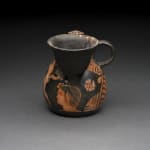Greek Vase Featuring Satyrs, 400 BCE - 300 BCE
Terracotta
height 15.2 cm
height 6 in
height 6 in
FF.21
Further images
In this Greek vase, so unusual in shape that it is impossible to classify it in the traditional manner, we stumble upon a rollicking party of Saytrs. The middle figure,...
In this Greek vase, so unusual in shape that it is impossible to classify it in the traditional manner, we stumble upon a rollicking party of Saytrs. The middle figure, leaps into the air, his right hand grasping an ornate typanum. Upon that drum he keeps time to the melody provided by the reed-flutes in the hands of his companions. Both painted as side-portraits, they frame the outstretched middle figure- making it seem as if the space he occupies is grander, and making his leap that much more dramatic and joyous. If we turn the vase we will notice under the perfectly formed spout an enormous portrait of the Saytr-beast which occupies the festival directly left of it. This creature casts a gentle eye upon the party at hand, his rounded nose and delicate eyes giving a touch of gravity to the whimsical face that is so dominated by the massive ears and eyebrows. Turning the vase further, our eyes fall upon a stunning and intricate pattern beneath the spout. A fan of palm fronds erupts forth from the base in perfect symmetry- graciously curving inward to allow a sinuous border to wrap around it and the handle itself. The shape of the vessel alone is enough to propel it into the categorization of a masterpiece. The offset spout is perfectly symmetrical, and seamlessly and flawlessly blends into the base of the piece. The cap is perfectly and acutely angled, giving a surprising element of sharpness to an otherwise completely round and curved piece. Such craftsmanship is rarely witnessed, even among the master-potters of Ancient Greece, and such creativity in regards to the shape, the placement of the spout, and the structure of the cap is practically never witnessed. This piece is a masterwork, a paramount display of artistry, pageantry, and the joys of celebration. Who knows what three Satyrs sat in symposia, pouring an endless maelstrom of wine from this vessel, enjoying one another’s company as much as the three depicted upon this vase? And while it may no longer be able to serve the most direct of its uses in the name of happiness and friendship, the artistry and nature of the piece is enough to do just that. What eye cannot be charmed by so vibrant a scene, what heart by so clear a depiction of love and camaraderie?







